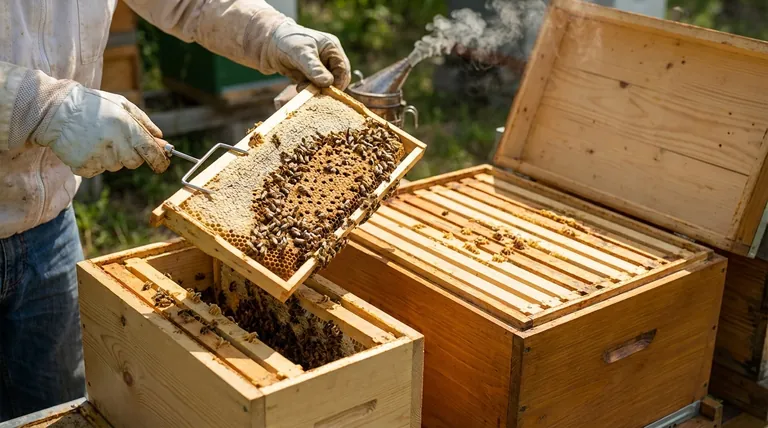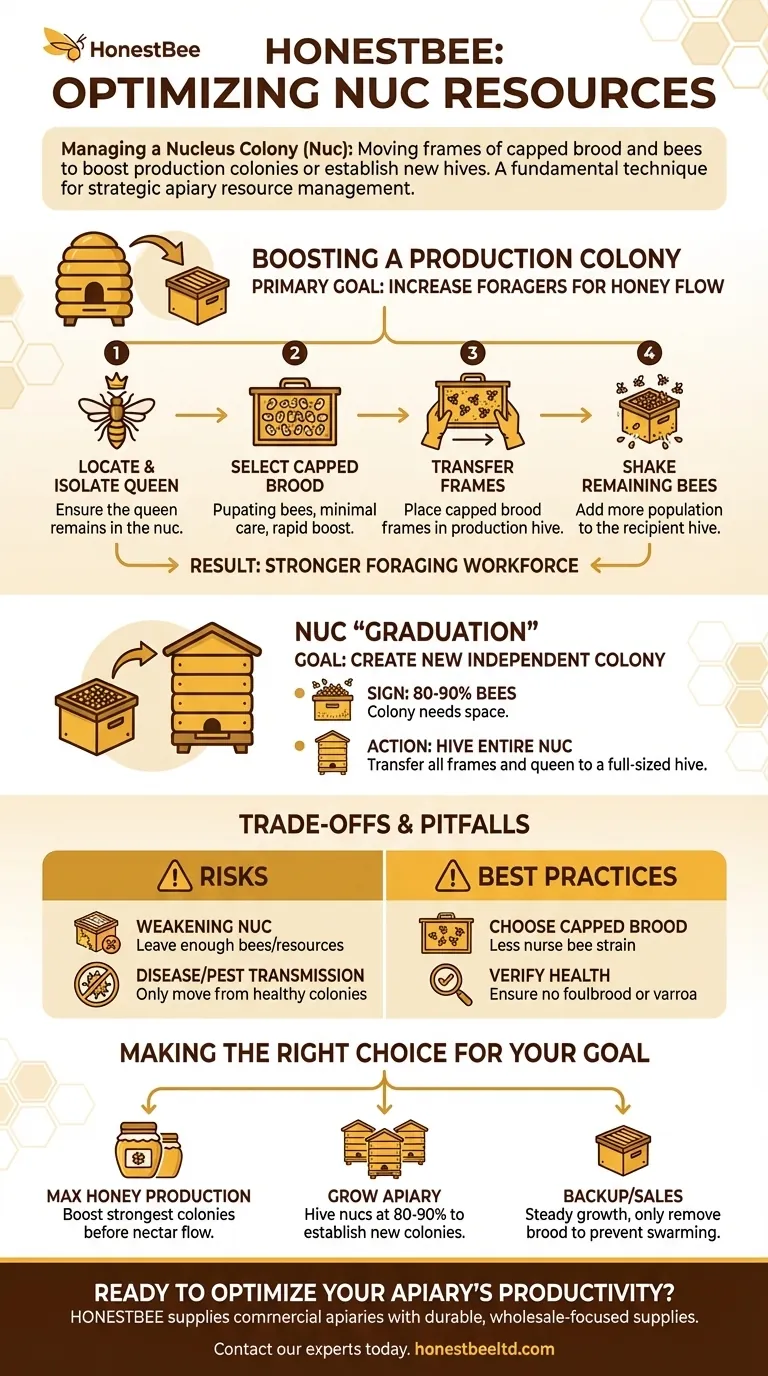When managing a nucleus colony (nuc), the frames of capped brood and the bees on them should be moved into a larger production colony to boost its population. This action must be taken with one critical precaution: ensure the queen is not on the frames being moved. After transferring the desired frames, any remaining bees in the nuc box can be shaken into the recipient hive to further strengthen it.
Moving frames of brood and bees is a fundamental technique for managing apiary resources. The decision is not just about what to do, but why you are doing it—either to strategically strengthen a specific colony for honey production or to give a successful, overgrown nuc a proper home.

The Primary Goal: Boosting a Production Colony
The most common reason to harvest frames from a nuc is to strengthen a full-sized "production" hive. A larger population directly translates to a more powerful foraging workforce.
Why Boost a Hive?
A surge of new bees, which will emerge from the capped brood, dramatically increases the number of foragers in the production colony. This boost is timed to coincide with a major nectar flow, maximizing the hive's potential to gather resources and produce a larger honey crop.
The Correct Procedure
First, locate and isolate the queen within the nucleus colony. She is the engine of the nuc and must remain there for it to survive and rebuild.
Select one or two frames that are mostly filled with capped brood. These frames are ideal because the pupating bees require minimal care and will soon emerge as adults, providing a rapid population increase.
Carefully lift these frames, with all their adhering worker bees, and place them in the center of the brood box of the larger production hive. The existing bees will quickly integrate the newcomers.
Finally, you can shake the remaining bees from the nuc box into the top of the production hive. These bees will join the larger colony, adding to its numbers.
When a Nuc is Ready to Graduate
Sometimes, the goal isn't to boost another hive but to promote the nuc itself. A strong, growing nuc will eventually need more space than its small box can provide.
Recognizing the Signs
A nuc is ready to be moved into a full-sized hive when it shows signs of high population density. If 80% to 90% of the frames are covered with busy bees, the colony is becoming congested and needs to expand.
Hiving the Entire Nuc
In this scenario, you are not harvesting frames but transferring the entire colony. All frames—containing brood, honey, and pollen, along with the queen and all the bees—are moved in their current order into a standard 8 or 10-frame hive body. This nuc is now a new, independent colony.
Understanding the Trade-offs and Pitfalls
While powerful, moving frames between hives is not without risk. A thoughtful approach is critical to success.
The Risk of Weakening the Nuc
Taking too many frames of brood or bees can severely weaken the nucleus colony. A nuc must be left with enough bees and resources to defend itself and allow the queen to continue laying. Never take frames from a weak nuc.
Disease and Pest Transmission
Moving frames is a primary vector for spreading diseases like Foulbrood and pests like Varroa mites. Only move frames between healthy, thriving colonies. Never attempt to "boost" a weak or sick hive with bees from a healthy one, as you are more likely to infect the healthy nuc.
Choosing the Right Brood
For boosting, capped brood is almost always the superior choice. Frames with a lot of unsealed brood (eggs and larvae) require a significant number of nurse bees to care for them. Moving them can place a strain on the recipient hive's resources, diverting them from other tasks like foraging.
Making the Right Choice for Your Goal
Your decision should be guided by your specific objective for the season.
- If your primary focus is maximizing honey production: Use frames of capped brood from your nucs to systematically boost the population of your strongest production colonies just before the main nectar flow.
- If your primary focus is growing your apiary: Allow your nuc to build up until it's 80-90% full, then transfer the entire colony into a full-sized hive to establish a new production colony.
- If your primary focus is creating backup queens or selling nucs: Manage your nucs for steady, self-contained growth, only removing a frame of brood if necessary to prevent swarming.
Ultimately, using a nuc's resources is a strategic choice that defines your path as a beekeeper.
Summary Table:
| Action | Primary Goal | Key Precaution |
|---|---|---|
| Move frames to a production hive | Boost population for honey flow | Ensure the queen is NOT on the frames |
| Hive the entire nuc | Create a new, independent colony | Wait until nuc is 80-90% full of bees |
Ready to optimize your apiary's productivity?
At HONESTBEE, we supply commercial apiaries and beekeeping equipment distributors with the durable, wholesale-focused supplies needed to manage nucs and production hives effectively. Whether you're boosting colonies for a major honey flow or expanding your operation, our equipment supports your strategic goals.
Contact our experts today to discuss how our solutions can help you achieve stronger, more productive hives.
Visual Guide

Related Products
- Professional Frame Comb Fork and Lifter for Efficient Handling
- Electric Honey Press Machine for Squeezing Honey Comb Press Equipment
- HONESTBEE Professional Bee Frame Machine for Side Bar Shaping
- Automatic Honey Flow Beehive 4 Frame Mini Hive for Beekeeping
- Electric Flatting and Embossing Machine with Tray for Beekeeping
People Also Ask
- What precautions should be taken when using a sharpened hive tool? Maximize Efficiency While Staying Safe
- How do you use Frame Grips during hive inspections? Achieve Calmer, More Efficient Hive Inspections
- How can beekeepers remember the timeline of bee development from egg to pupa? Use the 3-6-12 Rule.
- Why is a frame gripper important for beekeepers? Achieve Secure, One-Handed Frame Control
- What are the considerations when assembling unassembled frames for beehives? Ensure Hive Integrity and Honey Harvest Success



















